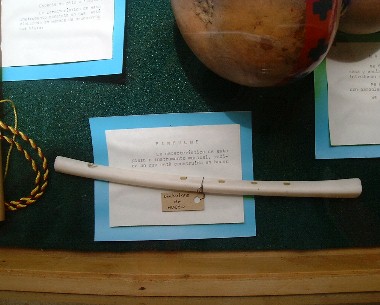| The next morning we got to the breakfast around
9AM and had tea, toast, ham and jelly. They gave Ceylon tea (dark
brew of orange pekoe) in bags. The mother was serving again.
This day there was one other couple in the room. After our breakfast,
we started the day with a drive towards Puerto Montt (about 30 km away).
Our plan was to get to Castro or Conchi in the Chiloe island. Chiloe
natives are called Chilotes. The name chilote is used in Chile to
refer to people who are not so smart. Somewhat like how the polish
immigrants are thought of in certain parts of Queens, NY. Chilotes
are short, stocky people, with a swaying gait while walking. The
gait must have come from being on boats to fish for a livelihood in the
bay and in the ocean . They had colourful yellow and blue wooden
boats. Yellow and blue seem to be the preferred painting scheme for
all outdoor structures.
We had a nice drive upto Puerto Montt after which it got a little drizzly. There was not much traffic on the road. We decided to refill our car with petrol before we took the ferry to the island, because we thought the island prices could be higher. Turned out to be the opposite. The lone gas station on this side was charging slightly higher. The road (highway 5 or Panamerican Highway) ended in the town of Pargua at the ferry pier. We drove up and joined the line. Within five minutes we drove on to the ferry. There were two buses with school girls parked next to us. There were three sidebyside rows. The ferry guy came to each car and gave tickets after the ferry was well underway across the channel. We paid $4500 for the trip. All the girls got out of the bus and went to the top walkway. There was a lot of giggling, taking photos and a few of them even leaned outside into the wind and smoked cigarettes. There were porpoises in the water on one side following the wake of the ferry. They looked like shiny black waves and went about quickly out and in. No way to take still photos.
Except for the seafood shops, many of the other
shops were selling clothes and brikabrak for the locals. Imported
Nicaraguan irregular jeans and painter´s pants were piled up in many
shops. On the water front we found the hotel Galeon Azul (referred
to in the Lonely Planet Guide), but this was painted all Yellow, but for
the Hotel´s name in Azul. Then we drove to Castro. The road was up and down with rolling hills on both sides. There were tall bushes with yellow flowers on both sides of the road. We saw a few bullock carts, the ones with car tire wheels, being pulled by what seemed like a pair of milk cows. The carts were usually hauling stuff and the driver was walking ?never riding- in front with a rope to the nose of each cow. What the guide book says about avoiding night driving is very good advice. These carts do not have any reflector or light on the back. We reached Castro after about an hour and a half of driving. It must have been around 3 or so in the afternoon. We parked at the centro in front of the post office. A parking girl with a handheld electronic printer came up, printed a parking ticket and placed it under the windshield wiper. In the center of town there was this majestic church with two light blue steeples. There were also some Cannons in front of it in the plaza. We visited their post office and mailed some postcards. This seemed like as far as we will go today. This was also the farthest point south we would have been on our trip. For us it is like sending the card from the end of the earth. We wanted to see how long before we would get mailed cards from here to the USA. Castro water front had many houses on stilts. There was a boat selling live sheep, and one
fellow who had reently bought a sheep was coaxing it up his horse drawn
cart. There was also a semi outdoor market for woolens there. Ebi
bought a pair of alpaca sweaters and one thick wool sweater. She
thought the sweaters made for the stocky build with short hands of the
Chilote must suit the Japanese. After many weeks the Japanese parents
were indeed surprised at how some imported sweaters from abroad could be
worn without the hands disappearing into the sleeves. The alpaca
sweaters were made extremely well with patterns running around the neck,
the hem and the sleeves. Right in front of the restaurant was the Anthropological
Museum. Since we were quite taken up with these short people, we
wanted to go in and see. At the door there was no one. After
a couple of minutes one young guy came and asked if we wanted to go in
and see. After asking where we were from, he gestured us to go in.
No fees. It was a small museum with various fishing and maritime
artifacts. In the room with the story of the natives, they had bones
of the people from a century ago. The full grown chilote of the last
century was only 4.5 feet tall. After the museum we came out to the plaza and saw a family restaurant that seemed to be serving a lot of locals as well as tourists. We went in and got summarily stared at by one and all. They were serving pancakes, eggs, burgers, fries etc.. We had ensalada Chileno and fries. This ensalada was onions and peeled tomatos with a sprinkling of salt and peppe, wwith grape oil dressing it tasted great. We had a few more of these salads in other places. And eventually got a large bottle of grapeseed oil to take home. The oil has a light green tinge to it. There were 4 elementary school girls seated next to us enjoying one large order of fries and individual sodas. The fries were short, thinner than American cut and extremely tasty. We recalled the various mounds of south american potatos from the Ancud market. After the meal, we paid the waiter at the table, went out, paid the parking maid (ca. 2.5 hours for about $400 ) and started our drive back to Puerto Varas. I estimated that we ought to clear out the Chiloe roads (carts with draft animals on the road !) before sunset and even be half way to Puerto Varas before dark. The return trip was as pleasant and quite eventless. A road sign near Puerto Montt for a suburb or subdivision said `Chin Chin´. This word has significance in Japanese for their children: during toilet training boys are told to aim their chinchin carefully so as not to spray outside the bowl. We stopped in Puerto Montt at the water front. After wandering about a bit and looking for a seafood restaurant that a girl on the waterfront tourist office suggested, we found ourselves in that famous Camino Astral, the road heading south. It was a gravel road and a long travel to the south of chile in such a road must indeed be difficult and lonely, especially if one were to have car trouble. There were many small houses, farms and a few large vacation homes. We came back to the town of Angelmo near Puerto Montt and had dinner in the Asturias Restaurant. The place has a crummy facade, but through the window we could see nice table settings with a bright yellow table cloth. We went in there and had another wonderful seafood dinner. Once again the Erizo appetiser with some nice bread to go with it. This Erizo was not as good as the first day´s but quite passable. |
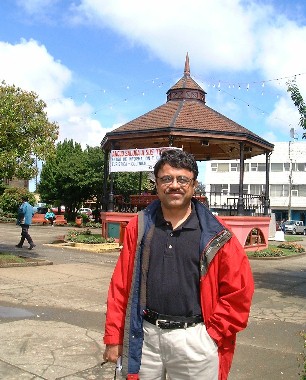 The island of Chiloe looked rocky as well as green. The ferry was
flat on both sides and we were but a meter above the water level.
They were running them one every 15 minutes on both sides. Apparently
there is a plan to build a causeway across the channel in the next five
years. Once that happens, the economy of the most depressed area
in Chile, the large island of Chiloe would improve a lot. Now they
seem to depend on fishing and rearing sheep. There were a few large
ice making factories (fishing) on the island. But for these we did
not see any industry.
The island of Chiloe looked rocky as well as green. The ferry was
flat on both sides and we were but a meter above the water level.
They were running them one every 15 minutes on both sides. Apparently
there is a plan to build a causeway across the channel in the next five
years. Once that happens, the economy of the most depressed area
in Chile, the large island of Chiloe would improve a lot. Now they
seem to depend on fishing and rearing sheep. There were a few large
ice making factories (fishing) on the island. But for these we did
not see any industry.
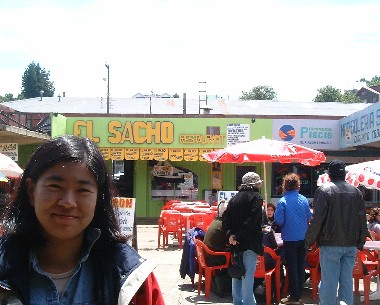 After we got off the ferry, we drove towards the town of Ancud. The
town sits on the mouth of the channel that goes out to the Pacific.
There were large fishing boats on the water everywhere. Ancud has
a nice center of town, with the obligatory church, plaza and many restaurants.
After loitering some in the center, visiting their visitor center ( not
much help with maps, spotty English ) we went to the Municipal Market for
lunch. There were clumps of restaurants within a plaza like seating
?plastic chairs and tables with umbrellas. The food was excellent.
The surrounding looked like it would not seriously recommend eating uncooked
seafood ? like Erizo. So we decided to try their Paella Marina.
This is the seafood soup that is served all over Chile. We had two
different varieties of soup. And some more crystal beer. The
temperature was in the low 20´s and pretty warm. This is a town where
Ebi got particularly stared at by many school girls. We found the
Chilotes in the streets ? and some of the faces were memorable.
After we got off the ferry, we drove towards the town of Ancud. The
town sits on the mouth of the channel that goes out to the Pacific.
There were large fishing boats on the water everywhere. Ancud has
a nice center of town, with the obligatory church, plaza and many restaurants.
After loitering some in the center, visiting their visitor center ( not
much help with maps, spotty English ) we went to the Municipal Market for
lunch. There were clumps of restaurants within a plaza like seating
?plastic chairs and tables with umbrellas. The food was excellent.
The surrounding looked like it would not seriously recommend eating uncooked
seafood ? like Erizo. So we decided to try their Paella Marina.
This is the seafood soup that is served all over Chile. We had two
different varieties of soup. And some more crystal beer. The
temperature was in the low 20´s and pretty warm. This is a town where
Ebi got particularly stared at by many school girls. We found the
Chilotes in the streets ? and some of the faces were memorable.
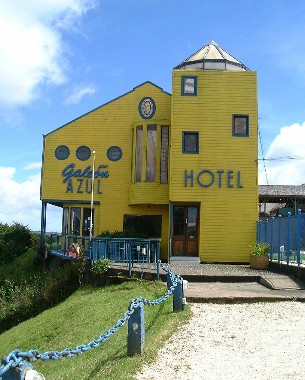
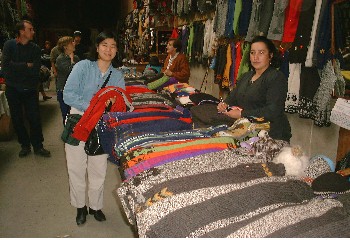 Ebi
took a photo with the shop lady who sold us the woolen sweater. When
not serving the customers, they were all busy with their knitting.
We went back to the centro area and found a rather fancy hotel with advertised
discount rates for rooms with hot tubs in them for US$60 per day.
Hotel Castro, we thought must have a nice restaurant to sit and be served
in style. We went up in the elevator to the 4th floor and saw the
restaurant, very elegant and completely closed and quiet. There
was also a large conference hall with seating for 200 or so. All
very nice and quiet. We used their very fine bath rooms and went
out.
Ebi
took a photo with the shop lady who sold us the woolen sweater. When
not serving the customers, they were all busy with their knitting.
We went back to the centro area and found a rather fancy hotel with advertised
discount rates for rooms with hot tubs in them for US$60 per day.
Hotel Castro, we thought must have a nice restaurant to sit and be served
in style. We went up in the elevator to the 4th floor and saw the
restaurant, very elegant and completely closed and quiet. There
was also a large conference hall with seating for 200 or so. All
very nice and quiet. We used their very fine bath rooms and went
out.
